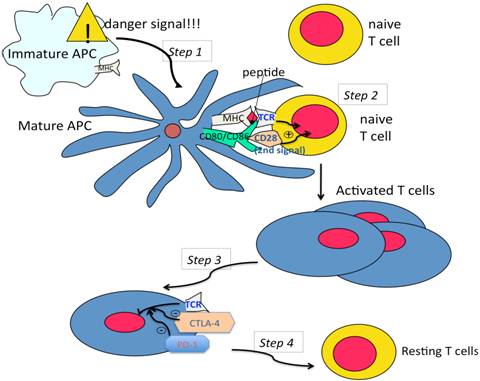BiteSized Immunology: Systems & Processes

Co-Receptors: Function
The activation of specialised immune cells from the adaptive immune response (i.e. B cells and T cells) is controlled by their specific antigen receptor but also by co-receptors.
T cell co-receptors
In order to be fully activated and ready to respond to intruders or damaged cells, naïve T cells (that haven’t contacted antigen) need to be activated by two signals. The first one is from the T-cell receptor (TCR). As the TCR recognises a small part of the antigen (called peptide), this ensures the specificity of the response; only T cells that recognise this antigen will be activated. The second signal (called signal 2 or co-stimulatory signal) is provided by a costimulatory molecule. The better characterised one is CD28, among others (ICOS, OX40, CD46…). Without receiving a second signal, the T cells remain mainly unresponsive, becoming anergic cells, or die. Cleverly, most of the ligands for these costimulatory molecules are induced by activation/maturation of the cells that present the peptide to the T cells (called antigen presenting cells, APC). When the APCs see an antigen and cut it into peptides for presentation in a complex with MHC molecules to activate T cells, they also upregulate the ligands for some of these costimulatory molecules, rendering them able to activate the specific T cells. For example, the ligands of CD28 (B7-1 and B7-2, also called CD80 and CD86) are induced on APCs and allow activation of CD28 on the T cells.
As one does not want continuous T-cell activation, there is also another set of co-receptors which inhibit T-cell activation. They are called co-inhibitory receptors, and include CTLA-4 and PD-1. These molecules are only expressed on T cells that have already been activated. Stimulation of these induced co-inhibitory receptors will curtail T-cell activation, and therefore contribute to a balanced immune response. Indeed, defects in these co-inhibitory receptors lead to aberrant immune responses, such as lymphoproliferation and autoimmunity.
The roles of co-stimulatory and co-inhibitory receptors in T cell activation are illustrated in Figure 1.

The adaptive immune response starts when an antigen presenting cell (APC) recognises a danger signal (virus, bacteria, damaged self…). This induces its maturation, the cutting of the antigen into small peptides for presentation in a complex with MHC, as well as the induction of ligands of costimulatory molecules (step 1). This allows the recognition of the peptide by the TCR of the specific T cell, and its activation by costimulatory molecules. As a result, T cells proliferate and are fully activated (step 2). Activated T cells then express co-inhibitory receptors (CTLA-4, PD-1) (step 3), which will terminate the T cell response (step 4).
B cell co-receptors
The specific B-cell receptor (BCR, an immunoglubulin molecule attached to the membrane of the B cell) recognises the antigen in native form, as opposed to the TCR that recognises antigenic peptides. Costimulation of B cells is notably achieved by the molecule CD40. CD40 ligand is expressed on T cells. As B cells can also present peptides to T cells, there is a dialogue between T- and B cells that allows continuous B-cell proliferation and optimal activation leading to their differentiation into plasmocytes, which are mature B cells producing high affinity antibodies against the original antigen.
© The copyright for this work resides with the author
